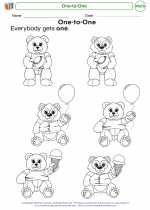One-to-One Correspondence in Kindergarten Math
In kindergarten math, children learn about one-to-one correspondence, which is the concept that each object in a set is paired with exactly one object in another set. This concept is important for developing a foundational understanding of numbers and counting.
Understanding One-to-One Correspondence
One-to-one correspondence helps children understand that each number they count represents one object. For example, when counting a set of five apples, children learn to pair each number they say with one apple until they reach the total count of five. This helps them understand the relationship between numbers and the quantities they represent.
Practicing One-to-One Correspondence
Kindergarten teachers use various hands-on activities and games to help children practice one-to-one correspondence. These activities often involve counting objects, such as using counting bears, blocks, or other manipulatives. For example, children may be asked to count a set of objects and place a manipulative on each object as they count to ensure they are matching each number with one object.
Importance of One-to-One Correspondence
Developing a strong understanding of one-to-one correspondence lays a solid foundation for more advanced math concepts in later grades. It helps children develop number sense, understand the concept of addition and subtraction, and eventually move on to more complex mathematical operations.
Overall, one-to-one correspondence is a fundamental concept in kindergarten math that helps children build a strong understanding of numbers and counting.
.

